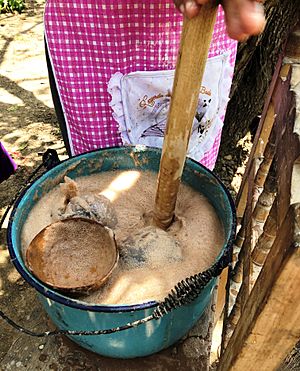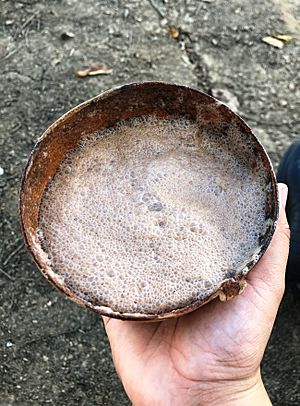Popo (beverage) facts for kids
Popo is a special cold and foamy drink from Mexico. It's popular in the southern part of Veracruz state and some areas of Oaxaca, like the Papaloapan basin.
The main ingredient in Popo is cocoa. It's sweetened with sugar or panela (a type of unrefined brown sugar) and mixed with water. To make it foamy, people add plants like azquiote (also called cocomeca in Oaxaca) or chupipi. Some recipes also add cinnamon or anise for flavor. Sometimes, it's made thicker with corn dough or rice.
Popo is a ceremonial drink, meaning it's made for important events. These include weddings, baptisms, birthdays, and local festivals. People usually drink Popo when cocoa is harvested, which is from August to December. In a town called Ojitlán, they use a special "tiger" cocoa bean because its fruits have white veins. In towns like Tuxtepec, you can often find street vendors selling a glass of Popo for about $10-15 Mexican pesos.
The name "Popo" comes from the Nahuatl word popocti. This word means "something that smokes" or "something that foams." This name refers to how foamy the drink is. It's even compared to the famous volcano Popocatépetl, which means "smoking mountain." Popo is very important to indigenous communities in Mexico. These include the Nahuas, Mixe-Popolucas, Zoque-Populucas, Mazatecs, and Chinatecs. For these communities, making Popo is a special ritual that can take up to two days.
How to Make Popo
Making Popo is a careful process that involves several steps. It starts with preparing the ingredients and ends with creating its famous foam.
Ingredients for Popo
To make Popo, you will need these main ingredients:
- Cocoa beans (Theobroma cacao)
- Fine white sugar or panela (unrefined whole cane sugar) (Saccharum officinarum)
- A foaming agent, which can be:
- Roots, young stems, or flowers of azquiote (Smilax domingensis). This is also called cocolmeca in Oaxaca.
- Roots, young stems, or fruit of chupipi (Gonolobus niger).
- Cinnamon stick or powder (Cinnamomum verum)
- Whole or powdered anise (Pimpinella anisum)
- Whole rice (Oryza sativa)
- Water
Step-by-Step Preparation
First, the rice is soaked in water to make it soft. At the same time, the cocoa beans are lightly roasted on a comal (a flat griddle). Some recipes use cocoa that was toasted the day before. It's important to toast the beans just enough, not burn them. Burnt beans can make the drink taste bitter and feel scratchy in your throat. After roasting, the cocoa beans are shelled, which means removing their outer skin. This step takes a lot of effort.
If the chupipi fruit is used, it needs to be peeled and chopped into small pieces. If azquiote stems are used, they are washed and also chopped. Cinnamon can be lightly roasted to bring out its smell, then cut into pieces. Sometimes, corn kernels or corn dough (masa) are also added. The corn is prepared through a process called nixtamalization. This involves using corn cob ash and corn leaves, then grinding and drying the corn in the sun.

All the ingredients are then ground together. This is traditionally done on a metate (a grinding stone) or in a special mill. They are ground until they form a thick paste. This paste is then mixed with water. The mixture is strained several times using a cotton cloth or a colander to make it smooth. Finally, sugar and ice are added. The drink is then foamed using a molinillo (a wooden whisk). It is traditional to serve Popo in a jícara bowl. People often enjoy it with spoonfuls, sometimes with a tamale on the side.
What Popo is Like
Popo is always served cold, usually with crushed ice. It is traditionally served in a wooden bowl called a jícara, which is known as guasca or xicalli in Nahua. The drink has a sweet taste and can be slightly spicy or spiced. Some people say it leaves a feeling of dryness in the mouth. A good Popo is known for having a lot of foam on top.
See also
 In Spanish: Popo para niños
In Spanish: Popo para niños


